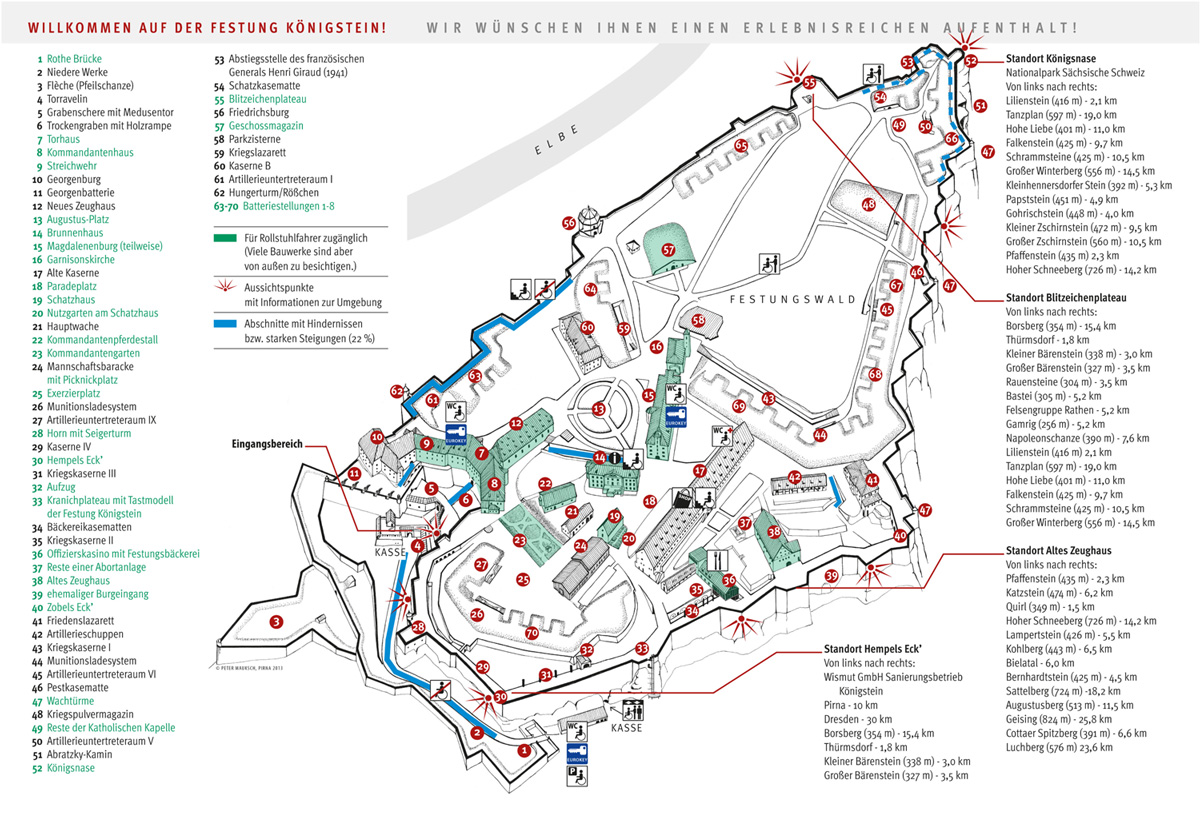FORTE CULTURA® Travel Recommendations
Experience World
Gate House Fortress Königstein, Foto: Bernd Walther
The impressive gate house received fortress visitors with artfully reliefs and protective defence facilities.
Commander House
The commander house is part of the gate house and served as tenement for the fortress commander and his family. This included the commander garden and the commander horse stable. The re-staged equipment of the commander apartment gives a good impression of the life in the early 20th century. The interior exhibition from around 1900 consists of the kitchen, study room and the boudoir of the family of the fortress commander.
Magdalena castle with huge wine barrel in cellar
Magdalena castle is a Renaissance castle and was built to accommodate the household and the provisions. The imposing historic wine cellar once had a huge wine barrel with around 240.000 litre of volume. It was the result of the competition between the elector of Saxony and the Palatine elector. A tour through this wine cellar is well worth seeing.
Frederics castle
Frederic castle is a former viewing and detaching tower and has one of the most beautiful view over the Elbe valley. In 1731 it was rebuilt to today’s baroque pavilion. A special highlight is that the round table can be completely lowered into the basement where it can be reset. The castle also includes a registry office and can be rented for festivities.
Old Armoury
Here, the military historic museum of the Federal Armed Forces is located. In the Old Armoury the history of the Saxonian arsenals is exhibited. It informs about the function of armouries as storage of weapons, equipment and trophies.
New Armoury
The visitors will see partly surprising perspectives of basic anthropologic and culture historic questions regarding fortresses. Rare weapons and unique items are presented as well as their function, ammunition, types of use and meaning within tactical and strategic planning.
Well House - History of the well and water pumping
The museum rooms in the Spring House offer a new experience. 20 years after the opening of the current exhibition in February 1998 it was remodelled and technical modernised.
Garrison Church
This church is the first Garrison Church of Saxony (1676), originally a romantic mountain chapel. In 2000 it was re-inaugurated after restoration. On chosen dates the Sunday music takes place in Garrison Church. Visitors can then see a 15-minute concert on the Jehmlich organ at the top of every hour between 12 and 4.15 pm. Furthermore, mass services are held on chosen Sundays at 10:30 am. Current dates can be found in the event calendar of fortress Königstein.
Treasury and kitchen garden
This building was used in quieter times as outsourcing location of the treasury. This was kept safe here in the 19th century and partly also during peace times (up to 2mio thaler).
Tour Offers and Information
Festung Königstein gGmbh
Permanent exhibition In Lapide Regis – On the stone of the king
Play along program for kids
„The Swedish conquer Königstein“
Fortress for the handicapped
Guided Fortress tours
Map
Monument and History
History King Wentzel the first of Bohemia, ruler over kingdom Bohemia, mentioned the medieval castle on Königstein with burgrave Gebhard vom Stein for the first time in 1233. The first complete title „Königstein“ in the Upper Lusatia border certificate was sealed by Wenzel I. “in lapide regis” (lat.: on the stone of the king). With the contract of Eger in 1459 Königstein was given to dukedom Meißen and therefore to Wettin electors.More information about history
Quelle: Festung Königstein gGmbH Quelle: National Gallery of Art, Washington DC Quelle: © Meißen Quelle: Festung Königstein gGmbH Quelle: Festung Königstein gGmbH Quelle: Kreidelithographie F. A. Zimmermann Quelle: Festung Königstein gGmbH
Architecture Elector Christian I. of Saxony and his followers had the existing castle rebuilt to the strongest fortress facility of Saxony between 1589 and 1597. They completed the rutted Table Mountain with high walls and built many of the today still preserved 50 buildings, for example the gate house, the prank weir, old barracks, Christian castle or the old Armoury. Further building phases in the 17th and 19th century completed the fortification facilities and the building ensemble. This makes the fortress Königstein an impressive ensemble of buildings of the late Gothic, the Renaissance and the baroque until the 19th century.
Quelle: Festung Königstein gGmbH Quelle: ©Procapter Quelle: ©DR Quelle: Festung Königstein gGmbH Quelle: ©DR Quelle: Festung Königstein gGmbH
Nature Experience Not only nature lovers are attracted by the unbelievable view over Saxonian Switzerland and the Elbe valley from fortress Königstein. The 1700m long panoramic walk along the fortress walls offers impressive view on every point.
Quelle: ©DR Quelle: ©DR Quelle: ©DR Quelle: Festung Kömnigstein gGmbH Quelle: Festung Königstein gGmbH Quelle: ©DR Quelle: Festung Königstein gGmbh
Partner







